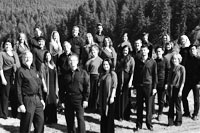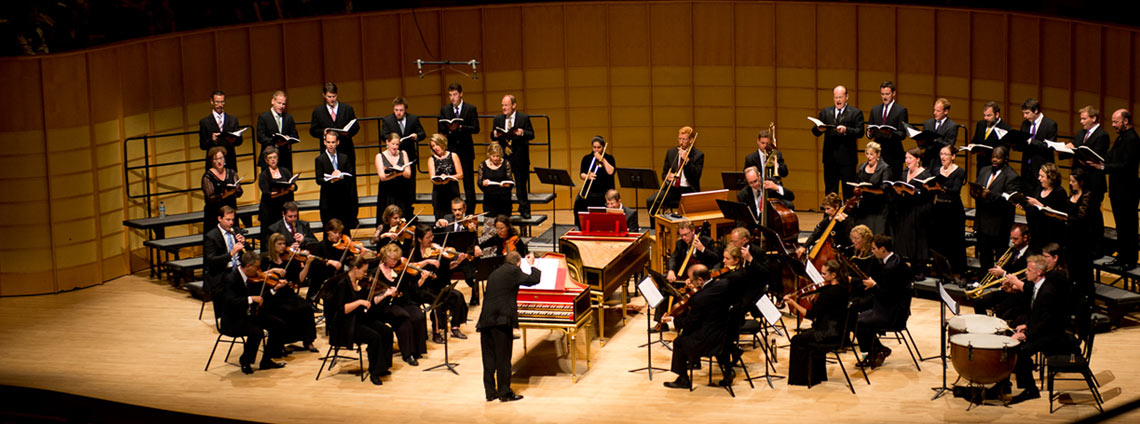Chan Shun Concert Hall at the Chan Centre for the Performing Arts | Map
David Fallis; EMV Vocal and Instrumental Ensemble; La Rose des Vents; Laudate Singers
A Northwest Baroque Masterworks Project
A collaboration in partnership with the Portland Baroque Orchestra, the Early Music Guild of Seattle, and Victoria’s Early Music Society of the Islands
David Fallis (music director)
EMV Vocal and Instrumental Ensemble
La Rose des Vents – cornetto & sackbutt ensemble
Laudate Singers – chamber singers
Thirteen vocal soloists specializing in seventeenth-century music from all over North America, string band, cornetto and sackbut players, three theorbo players, and multiple keyboardists join together to recreate the joyful celebration of Christmas Vespers as it might have been heard under the direction of Michael Praetorius in seventeenth-century Germany. In the festive spirit, the audience will join the assembled mass musical forces in singing favorite early Christmas carols.
“The music was balanced and period-perfect. The whole effort felt authentic in a natural, unforced way…David Fallis is a magician.” – The Toronto Star
Concert Programme
Concert Programme Insert
TEXTS AND TRANSLATIONS
PROGRAMME
Michael Praetorius (1571-1621) – except where noted:
Opening Chorale: Geborn ist Gottes Söhnelein
Psalm: Jauchzet dem Herren
Heinrich Schütz (1585-1672)
Ten Commandments: O Herr, das sind die deinen Gebot
Credo: Wir gläuben all an einen Gott
Lord’s Prayer: Vater Unser
Pavane d’Espagne
Hymnum de tempore: Quem pastores laudavere
Ballet des Amazones
Antiphon: Christum unsern Heiland
Magnificat Part I: Meine Seele erhebt den Herrn
Carol: Ein Kind geborn zu Bethlehem
Magnificat Part II: Denn er hat grosse Ding an mir getan
Carol: Freut euch ihr lieben Christen
Magnificat Part III: Er stösset die Gewaltigen vom Stuhl
Carol: Von Himmel hoch
Praetorius & J. H. Schein (1586-1630)
Magnificat Part IV: Wie er geredt hat unsern Vätern
Carol: Joseph lieber, Joseph mein
Johann Walther (1496-1570)
Collect: Der Herr sei mit euch
Blessing: Benedicamus Domino
Closing Chorale: In dulci jubilo
Praetorius & Walther
(NO INTERVAL)
PROGRAMME NOTES
Michael Praetorius is one of the most prolific and influential composers of the early German Baroque. There is some uncertainty about his birth date – contemporary sources suggest from as early as 1569 to as late as 1572 – but the most generally accepted date is February 15, 1571. He died on February 15, 1621 at the height of his powers, on his fiftieth birthday. During his lifetime he published an astonishing amount of music in a wide range of styles, from the simplest of chorale settings to the most complex polychoral masterpieces, and many of his compositions are still used in churches today.
His Polyhymnia Caduceatrix et Panegyrica (named after Polyhymnia, the muse of sacred poetry) is the largest and most important collection of Lutheran church music of the period. Published in 1619, it appeared after a period of six years during which Praetorius published his extensive three-volume theoretical treatise Syntagma Musicum but no music. This break in the chronology of Praetorius’ compositions is particularly notable because earlier, from 1605 to 1613 while he was both Kapellmeister and court organist to Duke Heinrich Julius of Brunswick-Wolfenbüttel, Praetorius produced sixteen volumes of music, sometimes four in a single year. But with the death of Heinrich Julius in 1613, Praetorius lost a supportive patron of music, and for the next few years, while retaining his posts at Brunswick-Wolfenbüttel, he travelled to and worked in a variety of north German cities, most notably Dresden, at the court of the Elector of Saxony.
Dresden was a leading centre of the most innovative Baroque musical techniques being developed at the time in Italy, and Praetorius would have come into contact with many Italian musicians and heard firsthand many newly-composed Italian works there. Polyhymnia Caduceatrix has been compared to Claudio Monteverdi’s volume of sacred music published in 1610 (containing the famous Vespers of 1610) in terms of both its variety and significance; the apt comparison also extends to the new Baroque musical techniques and forms of expression found in both volumes.
No work in Polyhymnia Caduceatrix displays these innovative techniques better than the last piece in the collection, a large-scale setting of the German Magnificat “Meine Seel erhebt den Herren”. Here, in one of Praetorius’ most important masterworks, one encounters all the wonderful new musical techniques which up until 1619 had not appeared in his music: masterful use of madrigalian word-painting; virtuoso ornamentation in the vocal writing; colourful use of a large basso continuo group; echo effects; elaborate instrumental ritornellos; contrasting vocal and instrumental forces, combined and recombined in seemingly infinite variety. And like Monteverdi’s Vespers of 1610, “Meine Seel” is also distinguished by a brilliant treatment of pre-existent plainsong material, in this case the so-called tonus peregrinus, a reciting tone to which the Magnificat was often chanted in Lutheran services. This simple melody can be found in one guise or another throughout “Meine Seel”, from the charming opening treble duet to the spectacular finale of “Und von Ewigkeit zu Ewigkeit, Amen”. “Meine Seel” does indeed compare favourably with Monteverdi’s brilliant and justly renowned music.
* * * * *
Although the word vespers derives from the Latin vesper, meaning evening, by the time of the early Baroque, vespers was the name given to the afternoon service of the church, and in both Catholic and Lutheran rites, the musical centrepiece of vespers was the singing of the Magnificat. But while the Lutheran mass retained almost all of the elements of its Catholic predecessor, significant changes occurred to the makeup of the reformed vespers service. To determine the form of the Lutheran vespers service in Praetorius’ time, we have consulted various north German “Instructions to Churches” or Kirchenordnungen from the late 16th and early 17th centuries. While is is fair to say that regional variants are found more often in vespers services than in the morning mass, certain common elements are discernible.
The most important factor affecting the vespers service was the fact that Sunday afternoons in the Lutheran tradition were centred on the instruction of young people learning their catechism. According to most of the Kirchenordnungen consulted, the catechism students gathered at one o’clock to examine and learn the essential elements of the faith, with special emphasis on the psalms, the Lord’s Prayer, the Creed and the Ten Commandments. At two p.m. the vespers service began, with the young people being joined by the wider congregation. Where the Catholic vespers service contains five psalms and the Magnificat as its main musical elements, the 17th-century Lutheran vespers reduces the psalms to one or two, retains the Magnificat, but adds pieces the young people had been studying in the hour before, namely the Lord’s Prayer, the Creed and the Ten Commandments. These last occur, with the reading for the day and a psalm, at the beginning of the service. Then follows a seasonal hymn, a sermon, the singing of the Magnificat (sometimes in German, sometimes in Latin), the collect of the day, and finally the blessing Benedicamus Domino.
* * * * *
Today’s performance reconstructs a possible vespers service for Christmas as it might have sounded in a large north German church in the early 17th century. A number of important performance practice issues have been addressed, as suggested by Praetorius’ writings and contemporary tradition.
In Megalynodia Sionia Praetorius publishes a number of Magnificat settings with German carols or hymns inserted at various points into the Magnificat. A further carol follows at the end. As he explains elsewhere, this is to allow the “best-loved German songs” to be sung in the vespers service, a practice which was most common at Christmas time, but which Praetorius suggests could be used on any important feast day. He recommends that only one or two verses of the hymn be sung, and provides a wide selection of the kind of pieces appropriate for insertion.
This practice of adding music into the Magnificat was widespread and long lasting. (There is a version of J. S. Bach’s Magnificat with Christmas carol insertions.) In the early 17th century, whole volumes of Christmas music were published in which the bulk of the examples were deemed suitable for insertion into the Magnificat at Yuletide. Some scholars have suggested that the practice arose because the pageants at the crib required non-liturgical excuses for more carols, and it is true that some of the most commonly found insertions, such as “Joseph lieber” and “Von Himmel hoch”, centre on the Christ child at the manger. For this performance we have selected our interpolations from among Praetorius’ many suggestions, being guided by his advice of an upper limit of two verses per carol, except in the case of “Ein Kind geborn” where we have followed the example of his “Magnificat super Ecce Maria” in which he inserts a number of verses of “Geborn ist Gottes Söhnelein” with each successive verse employing an added voice. “Meine Seel” is divided by Praetorius into four parts, allowing for easy and logical insertion points.
Although the Kirchenordnungen seem to suggest that vespers normally ended with the blessing, at the end of our service we have added “In dulci jubilo”, one of Praetorius’ recommendations for music which can “be sung and used at the place of the Benedicamus and for the going forth”. The opening verse of this famous chorale is one of many examples of music by Praetorius marked “ad aequales” in which three treble voices are accompanied by a bassetto part. Following Praetorius’ suggestion elsewhere in Polyhymnia Caduceatrix, we accompany the three trebles with a curtal playing down the octave.
In undertaking this reconstruction, while we make no claim that this is an actual service of worship, we wanted to incorporate into the music-making the aspect of congregational participation, so essential to the reformed tradition. This means two things. First, we are joined in each of the cities on our tour by a wonderful local choral ensemble participating as the German congregation, and singing where a 17th-century congregation would have joined in. Musically, it has been fascinating to experience the added richness of male congregation members singing the melody down an octave, especially in the context of elaborate polyphonic settings such as the final verse of the Creed, or Johann Hermann Schein’s arrangement of “Von Himmel hoch”. In all of the Magnificat insertions, and in the chorales sung elsewhere in the service, we have employed Wechselgesang, the practice of alternating verses of a hymn between the congregation singing in unison to the accompaniment of the organ (choraliter) and the assembled professional musicians performing more elaborate versions (figuraliter), sometimes ending with a version which combines both methods, that is, with a clear unaltered melody in the top part, and contrapuntal complexity in the other parts.
Secondly, we would like you the audience to take part in this “exchange” during two well-known 17th-century Christmas carols. In each one, the musicians onstage and the audience will sing alternate verses. (Incidentally, you will be singing in English, the musicians in German or Latin; but this too is very much in the spirit of the 17th century, when often the congregation sang in the vernacular, and the choir sang in Latin.)
Both Wechselgesang and the interpolations into the Magnificat provide the congregation with opportunities to participate in the music-making of the more highly trained musicians. In the history of sacred music there has always existed a tension, not easily resolved, between the desire for musical participation by the assembled worshippers and the abilities and aspirations of the professional musicians. In a 17th-century Lutheran vespers service, on a feast day such as Christmas blessed with many familiar and beloved hymns, a balance and integration of these competing desires is achieved which has not often been matched elsewhere in the history of music.
– David Fallis

David Fallis
David Fallis has been a member of the Toronto Consort since 1979 and its Artistic Director since 1990. He has led the ensemble in many critically-acclaimed programs, including The Praetorius Christmas Vespers, The Play of Daniel, all three of Monteverdi’s operas in concert, Cavalli’s La Calisto and Carissimi’s Jephte, among many others.
He has directed the group in its many recordings and tours, and has conceived and scripted many of their most popular programs, such as The Marco Polo Project, The Queen, and The Real Man of La Mancha. He is also one of Canada’s leading interpreters of operatic and choral/orchestral repertoire, especially from the Baroque and Classical periods. He is Music Director for Opera Atelier and has conducted major operatic works by Mozart, Monteverdi, Purcell and Handel in Toronto and on tour to Japan, Korea and Singapore. He has conducted for Houston Grand Opera, Cleveland Opera, Wolf Trap Theatre, Utah Opera, Orchestra London, Symphony Nova Scotia, the Windsor Symphony, Festival Vancouver, the Singapore Festival, the Seoul Arts Centre (Korea), the Elora Festival, the Guelph Spring Festival and the Elmer Iseler Singers. Currently he teaches in the Graduate Department at the Faculty of Music at the University of Toronto.
EMV Vocal and Instrumental Ensemble
The Early Music Vancouver Vocal Ensemble is selected by Artistic Director Matthew White from an international pool of artists. Unburdened by a fixed membership, its greatest asset is its ability to assemble the ideal forces for any given project. Given the breadth and variety of repertoire we present at Early Music Vancouver, this flexibility allows the ensemble to fit the needs of the music and not the other way around.
La Rose des Vents
La Rose des Vents, Montreal’s newest early music group, was founded by historical trombonist Catherine Motuz and cornettist Matthew Jennejohn. The ensemble has been playing together in various guises since 2009, when it combined with Les Voix Baroques to perform at the Ottawa International Chamber Music Festival. The name La Rose des Vents – “The Compass Rose” – reflects the spirit of exploration in early music.
In formations from the Renaissance city wind band to the lavish sacred ensemble of the Baroque, La Rose des Vents seeks to promote musical dialogues, story-telling, bringing expressive devices to the foreground of performance. Our concerts have an emphasis on improvisation, exploring early ideas about expression while giving players the freedom to play with ideas, a freedom inherent to chamber music.
The sackbut and cornetto were both renowned in their day for their ability to imitate the human voice, both in their malleable timbres and in their ability to use different articulations in order to imitate speech. Many of our activities will therefore involve collaborations with vocal groups. On October 1st, 2011 we gave a concert as guests of the acclaimed Montreal choir VivaVoce with repertoire from an original Reniassance wind band, and later that year combined with the Ottawa Bach Choir for a concert of German and Italian Christmas music.

Laudate Singers
Laudate means praise, and for Laudate Singers, every concert is a joyful celebration. Founded in 1995 by current artistic director Lars Kaario, this professional chamber choir skillfully and passionately presents repertoire that spans centuries, cultures and genres.
Whether it’s medieval, Baroque, Renaissance, classical, Romantic or contemporary…great choral works of the Western canon or music from the Celtic, South African, Latin American, Chinese, Finnish, Quebecois, or Coast Salish traditions (to name only a few)… Laudate Singers combine technical artistry with the ability to make all kinds of choral music accessible, and the final result is always luminous and transcendent.
Laudate Singers are committed champions of Canadian choral music; the choir has maintained a composer-in-residence program since 1995, and commissions and performs new Canadian works every season. Audiences at Laudate Singers’ concerts are almost always guaranteed the thrill of knowing that some of the music they are listening to has never been heard in public before! The choir has recorded four critically-acclaimed CDs: A Baroque Christmas, Christmas Journey, Songs of Heaven and Earth, and Celtic Journey.
Laudate Singers
Laudate Singers firmly believe that music cannot happen in a vacuum; community outreach is a pillar of the choir’s mandate. Laudate Singers have given workshops for young choirs and educational concerts for school children. Travelling farther afield, the choir was honoured to represent North Vancouver at the Chiba (Japan) Cultural Festival in October 2009. Laudate Singers were also featured in the VSO’s gala tribute to his Holiness the Dalai Lama in April 2004, and were invited to be choir-in-residence at the International Choral Kathaumixw in 1996. The choir has given concerts throughout central BC, and has performed at West Vancouver’s Harmony Arts Festival, WinterSong and MusicFest Vancouver. Laudate Singers have also undertaken stimulating, innovative partnerships with such ensembles as the Vancouver Inter-Cultural Orchestra, La Cetra, Pacific Baroque Orchestra, CBC Vancouver Orchestra.





